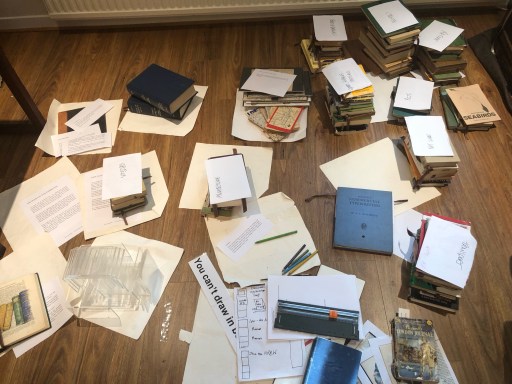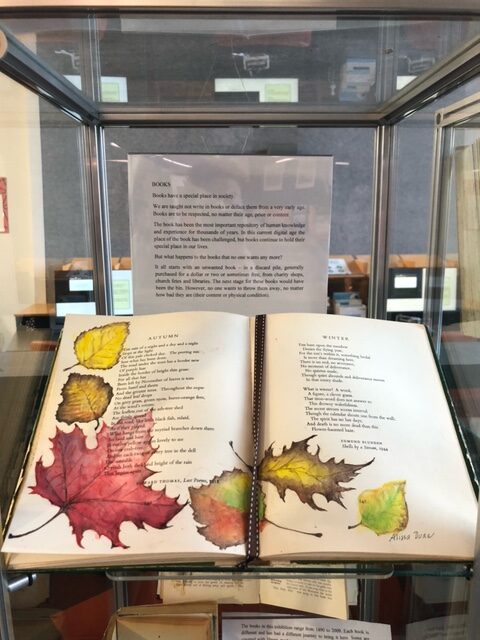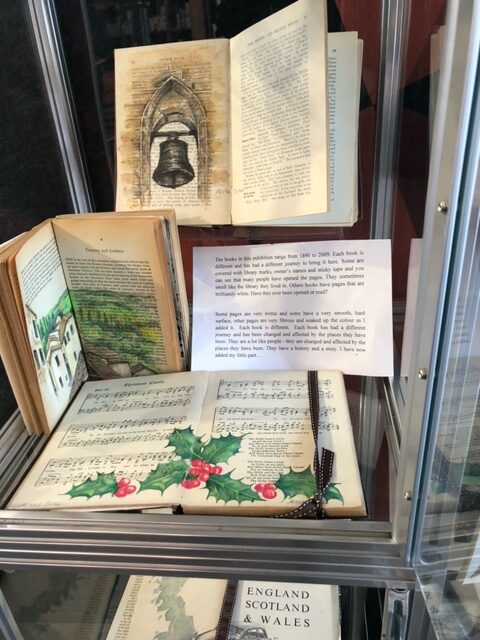This week is part two of my sketches as the official “sketcher on Location” for Melbourne Rare Book Week (MRBW) . Last week’s blog covered the first three days.
The motto for Melbourne Rare Book Week is For the Love of Books. Melbourne Rare Book Week began in 2011 and after a COVID-19-induced hiatus, Rare Book Week returned with a wide range of events. The program has been generously supported by donors who have helped to ensure that all events are free, giving everyone the chance to enjoy the rich collections Melbourne has to offer. MRBW culminates in Melbourne Rare Book Fair which is in its 51st year. It is a major event in the Australian antiquarian book year, with a rich and diverse array of items. with prices to suit all levels of collecting.


I moved to Melbourne in October 2014 and a friend introduced me to the book-collecting community. In 2015 I attended and sketched at four Melbourne Rare Book Week talks. I have been involved with MRBW since 2016 as official “sketcher on location”. Many of the events are held at Libraries, sharing their collections. As a Librarian, who works in Library that was establishd in 1856., I have a great connection with them. That year I sketched at 20 of the 55 events of “the week” (which is actually ten days) and posted on my blog every evening.
This year MRBW returned with 21 events.
Each year I take a week of Annual Leave and sketch at all events where possible. My sketches are done on location in the 45-60 minutes of the talk. They are all about capturing the moment. It is an impression of the event and being there. (there is not a lot of actual likeness to the presenter’s faces). I try and include the space the event is being held in.
I use a Lamy Safari Joy ink pen and FaberCastell Watercolour pencils in a 13 x 19 cm Moleskine watercolour sketchbook. I scan all of my sketches for my own record and put them in Albums on Flickr, a photosharing site. All of my sketches go there. I also share on social media
Facebook Alissa Duke Art
Instagram alissaduke1
and send all sketches to MRBW who use them on their social media and also in the Australian and New Zealand Association of Antiquarian Booksellers (ANZAAB) newsletter.
Below are the events I attended, It was another fascinating program with a look at amazing collections held here in Melbourne. The speakers provided their specialist knowledge to provide insight into the importance and relevance of each collection.
First Glimpses of the Antarctic
Prior to the 18th and 19th centuries, Antarctica was the great unknown:
how could nature survive in temperatures averaging -57 C? And just
how large was the continent? Join reference librarian and Antarctic
history buff Andrew McConville for this special tour, to discover how
Antarctic exploration was recorded, and Melbourne’s role in reviving
voyages in the later part of the 19th century. There will be the
chance to see documents chronicling the first recorded landing and
exploratory expedition on the Antarctic continent.

Collecting Australian Internment Ephemera
Edwin’s collecting interests include the impact of the world wars in Australia.
The records of internees are diverse, often not in English, and from all parts
of the country. They reflect the skills of the internees as well as their ordinary
day to day needs, such as setting up cafés and barber shops. His collection
includes rare camp newspapers, postcards, artworks and linguistic aids.

Rare Books from the RHSV collection
The RHSV has had an active collecting policy both in Australia and back ‘home’ in the UK since its start in 1909. In the 1920s, when the Victorian Branch of the Royal Geographical Society (RGS) closed, their archive and library were absorbed by the RHSV. Whereas the RHSV collection is concentrated on Victoria, the RGS collection is much broader, covering exploration across Australia and the Pacific and, because of this ‘misfit’, their collection was not catalogued until recently. Jillian will speak about two explorers’ journals and the Moll atlas.

Printing the plays of Shakespeare and company in the 17th century
2023 marks the 400th anniversary of the publication of the First Folio of the Plays of William Shakespeare. This lecture will place this milestone of literary publishing in the broader context of similar folios containing the work of other writers. Dr McInnis is widely published on Shakespeare, is a Fellow of the British Royal Historical Society, and is Australia’s leading authority on the Bard. After the lecture, the audience will be invited to inspect a rare Second Folio of Shakespeare’s plays currently for sale at Kay Craddock’s antiquarian bookshop.

More than Romance: The witty world of Georgette Heyer
First published at just 19, Georgette Heyer went on to become one of the world’s bestselling authors, beloved for her clever, witty historical novels and golden age detective stories. Her Regency novels set the benchmark for the genre that she created. Notoriously private, she did not believe in the need for personal publicity to sell her books, resulting in signed Heyer novels being exceedingly rare. This talk will shed light on the enigmatic writer, her world, her wit and the struggles she faced in both her personal and public life, as well as on the phenomenal success she achieved during her lifetime and beyond.

Into the Archive: Creating Designer Books
The RMIT Design Archives is a unique repository of Melbourne design practice. This session will focus on two publishing collectives, established in the 1970s in Prahran: Backyard Press, a commercial venture and Champion Books, an experimental publishing house. Marius Foley joined Backyard Press shortly after its establishment by Ted Hopkins, Sharon Hill and Paul Greene in 1976. In this session he will share his insights into this collaborative and experimental publishing workplace. There will be the opportunity to view the original publications in the Archives’ collection

Rare Sports Books and Ephemera: Recent Acquisitions
The MCC Librarians will discuss some of the rare items that have entered the collection since their last Melbourne Rare Book Week presentation in 2019, with a highlight being an illustrated scorecard from an international cricket match at the MCG in 1862. A panel of sports writers and historians will discuss trends in rare sports book collecting over the past four years, followed by their now traditional Q&A session with the audience.

The Bounty and Beyond
Paul Brunton OAM, State Library of New South Waleswill launch The Bounty and beyond: A textual and bibliographical investigation of William Bligh’s journals of the first breadfruit expedition, a major new study of Bligh’s Bounty journals by John A Fish. This fully catered event will provide guests with an introduction to this important work as well as the opportunity to discuss this perennial maritime favourite with experts and enthusiasts alike.

Collective City : Photographic Exhibition launch
This exhibition, curated from submissions by contemporary street photographers, features historic images of Melbourne from our state and federal government archives, alongside images representing Victoria today. It looks at ways people connect and work together in Victoria’s urban and suburban environments, and also examines the divisions created by inequity of access to services and public spaces. Join us for a drink to celebrate the launch of the exhibition.

Curators’ tour of World of the Book
Join the curators of World of the Book for a special tour of the rare, sacred, iconic and historically significant books within the Library’s most popular exhibition. Celebrate Rare Book Week and chart the rise and restyling of the beloved book, with medieval manuscripts, Egyptology, 1950s pulp fiction and contemporary works of art and design all on display. Located in the galleries overlooking the magnificent La Trobe Reading Room, this exhibition celebrates the unique place of books in our hearts and minds.

Meet me at the book Fair
For first time visitors, an antiquarian book fair might seem to be a strange and unfamiliar experience. We invite you to join an experienced book collector in a small group visit to some of the exhibitors and an introduction to the joy of collecting books and print on paper.

I did not have the opportunity to sketch at a few events
Shaping Stories by Prahran Mechanics Institute Library All stories are shaped by the documents that survive to tell them by Ellen Coates
Female Australian Poets of the First World War Female Australian Poets of the First World War by Major General (Ret’d) Michael O’Brien CSC, MDA, BSc (Mil)
You Can’t Draw in Books? by ME – I gave a one hour talk about the books at the other end of the scale – the books that noone wants. I draw on the pages of books that are about to be discarded. I have a good audience of 44 people and it went well. This was a talk where people could come up and handle the books. They are for sale on my ETSY online store.
I also had a display at my local Library and gave TWO radio interviews !!!!! They were only ten minutes each and I think they went well. One was on Community Radio 3MRD with Jules Vine in her “Classically Saturday” show and the next with ABC Victoria with David Astle. I have learnt that he has a wide audience and is famous for cross words. Tim Finn was on his show later that night !!
and so now life returns back to normal routine .
I have my Travel Sketching with Watercolour Pencil classes here in Melbourne and others planned for later in the year.
.





























































